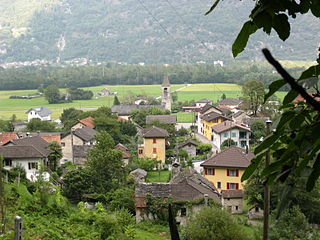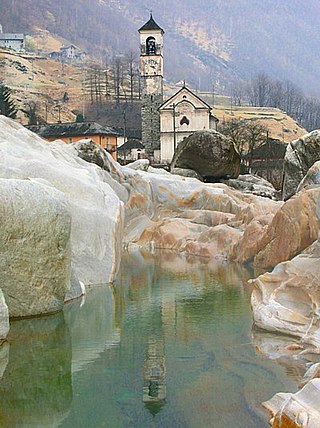
Arogno is a municipality in the district of Lugano in the canton of Ticino, located south of Lake Lugano in the southernmost tip of Switzerland.

Aranno is a municipality in the district of Lugano in the canton of Ticino in southern Switzerland. Bordering municipalities are Cademario, Iseo, Alto Malcantone, Miglieglia and Novaggio.

Bissone is a municipality in the district of Lugano, in the canton of Ticino in Switzerland.
Morbio Superiore was a municipality in the canton of Ticino in Switzerland in the hills above Chiasso. It is located in the district of Mendrisio. On 25 October 2009 the municipalities of Bruzella, Cabbio, Caneggio, Morbio Superiore, Muggio and Sagno merged into the municipality of Breggia.
Muggio was a municipality in the district of Mendrisio in the canton of Ticino in Switzerland. On 25 October 2009 the municipalities of Bruzella, Cabbio, Caneggio, Morbio Superiore, Muggio and Sagno merged into the municipality of Breggia.
Cabbio was a municipality in the district of Mendrisio in the canton of Ticino in Switzerland. On 25 October 2009. the municipalities of Bruzella, Cabbio, Caneggio, Morbio Superiore, Muggio, Sagno, and Breggia merged into the municipality of Breggia
Bruzella was a municipality in the district of Mendrisio in the canton of Ticino in Switzerland. On 25 October 2009 the municipalities of Bruzella, Cabbio, Caneggio, Morbio Superiore, Muggio and Sagno merged into the municipality of Breggia.
Sagno is a former municipality in the district of Mendrisio in the canton of Ticino in Switzerland; it is now part of the new municipality of Breggia. On 25 October 2009 the municipalities of Bruzella, Cabbio, Caneggio, Morbio Superiore, Muggio, Sagno merged into Breggia.
Campello is a former municipality in the district of Leventina in the canton of Ticino in Switzerland. On 1 April 2012, it was incorporated into the municipality of Faido along with the former municipalities of Anzonico, Calpiogna, Cavagnago, Chironico, Mairengo and Osco.
Personico is a municipality in the district of Leventina in the canton of Ticino in Switzerland.

Moleno is a former municipality in the district of Bellinzona in the canton of Ticino in Switzerland.
Indemini is a former municipality in the district of Locarno in the canton of Ticino in Switzerland.

Lavertezzo is a municipality in the district of Locarno in the canton of Ticino in Switzerland.

Vergeletto is a former municipality in the district of Locarno in the canton of Ticino in Switzerland. On 10 April 2016 the former municipalities of Vergeletto, Gresso, Mosogno and Isorno merged into the municipality of Onsernone.

Bogno is a former municipality in the district of Lugano in the canton of Ticino in Switzerland. On 14 April 2013 the former municipalities of Bogno, Cadro, Carona, Certara, Cimadera, Valcolla and Sonvico merged into the municipality of Lugano.

Origlio is a municipality in the district of Lugano in the canton of Ticino in Switzerland.
Maroggia is a former municipality in the district of Lugano in the canton of Ticino in Switzerland. On 10 April 2022, the former municipalities of Maroggia, Melano and Rovio merged to form the new municipality of Val Mara.

Melide is a municipality in the district of Lugano in the canton of Ticino in Switzerland. The village lies very close to the mountain Monte San Salvatore and is directly on the Lake of Lugano. The Melide causeway to the east was built to make it possible to cross to Bissone and to allow a north–south highway to be built.
Mezzovico-Vira is a municipality in the district of Lugano in the canton of Ticino in Switzerland.

Breggia is a municipality in the district of Mendrisio in the canton of Ticino in Switzerland. On 25 October 2009 the municipalities of Bruzella, Cabbio, Caneggio, Morbio Superiore, Muggio and Sagno merged into the municipality of Breggia.















